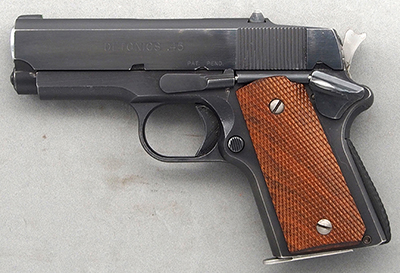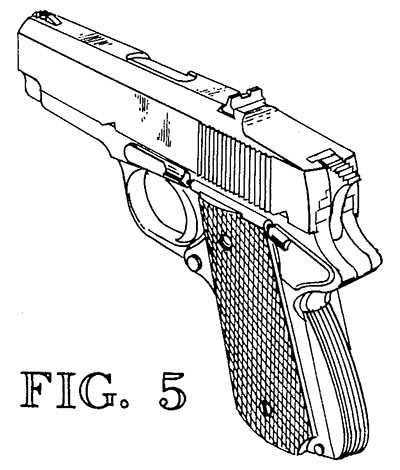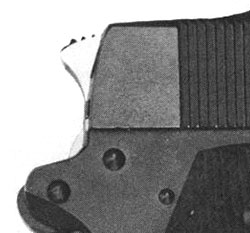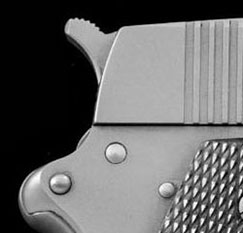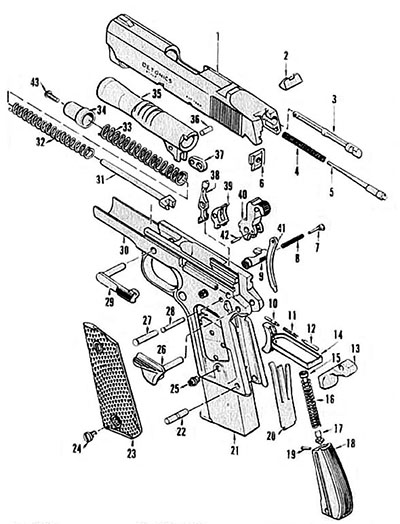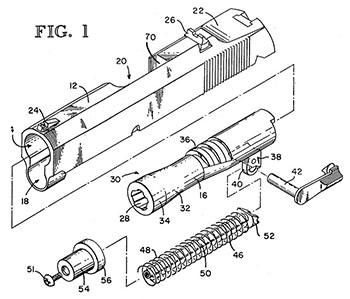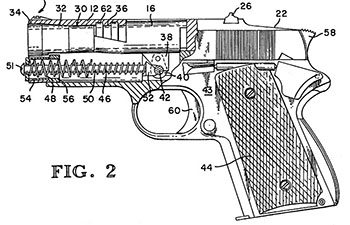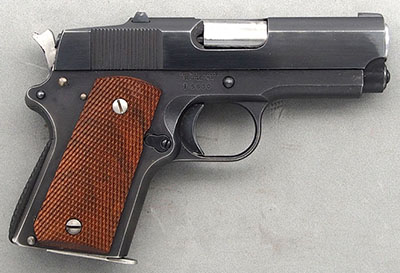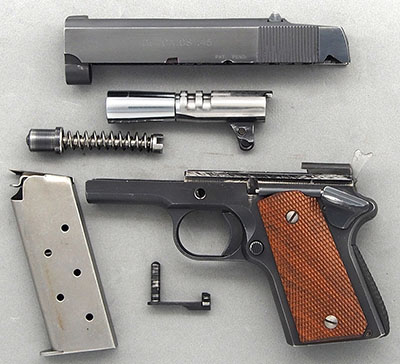 |
||||||||||||||||||||||||||||||||||||||||||||||||||||||||||||||||||||||||||||||||||||||||||||||||||||||||||||||||||||||||||||||||||||||||||||||||||||||||||||||||||
|
Pat Yates, Sid Woodcock, and the Detonics Combat Master I thought, does the world really need another article on the Detonics Combat Master pistol? Possibly not, but I was interested enough to read everything I could find on the gun and I discovered there is a certain amount of misinformation out there. I read Allen J. Chinn’s book, Combat Master: Sid Woodcock and Detonics, and
thought it could use a review. Plus, I recently acquired a Detonics Combat Master of my own and thought I thought I ought to write a brief evaluation of it. So my article began to formulate itself along the lines of
a history of development, a brief book review, and a range report for a classic Combat Master. The Detonics Combat Master is well known as the first reliable compact .45 ACP pistol that was smaller than the Colt Commander. It’s short grip and unusual profile make it instantly recognizable. The Combat Master is still highly regarded even 40 years after it was first made.
Yates worked with three used Colt 1911s he bought at a pawn shop, cutting and welding as necessary. The grip height was shortened by about 3/4 inch and the barrel and slide length were reduced by an inch and a half. He eliminated the barrel bushing and made the barrel cone-shaped so it would always lock in the same position when the slide was in battery. He used three recoil springs, one inside the other, with the coil direction
According to Yates, Sid Woodcock had been a manager at the Explosives Corporation of America, but had left to form his own explosives company which he called Detonics. Yates sold Woodcock the rights to the gun in 1974. As he says: “Sid...convinced me the little .45 was worth patenting and producing, so I sold the rights to Detonics, helped them fight through the patent flail, prepared for them a set of engineering drawings of the complete gun and offered whatever assistance I could manage in getting it into production.” Yates loaned Detonics his prototype pistol for a year or more until they could make a working prototype of their own. The final Detonics design differed from the prototype in several ways, including no hammer spur, no recoil buffer, two instead of three recoil springs (a few guns were produced with three, and eventually the company returned to the three-spring design), a full-magazine indicator, and many other small details. The hammer, slide, frame, and grip plates are necessarily unique to the Combat Master, but the slide stop, manual safety, magazine release, trigger, sear, and disconnector are all interchangeable with standard Colt parts. Colt magazines will work in the Detonics as well.
The Detonics does not appear in Gun Digest until 1978, listed at $395, which was quite expensive, as the blued Colt Government Model and Combat Commander in the same issue were each listed at $235. George C. Nonte gives the Detonics a few paragraphs in his “Handgun Report” in that same 1978 issue. He says: “This is a production gun, using a cast-steel frame designed expressly for it. It is not simply a cut-and-welded Colt. Workmanship on production examples seen is good and they appear to handle well—though the big-handed may find the butt uncomfortably short.” Nonte later reviewed the Combat Master in the July/August 1979 issue of American Handgunner, but I see no need to quote from it here, other than to note that early Detonics pistols had some reliability issues which were apparently worked out by the time of Nonte’s test in early 1979.
In his 1987 book, Great Combat Handguns, Leroy Thompson says of the Combat Master: “I rate the Detonics...as the best combat handgun on the market for someone needing good knockdown power and concealability in the same package. No other gun offers this combination as efficiently...and, despite the expense, one gets an ‘off the shelf’ quality usually associated only with specialist customization.” The original Detonics company lasted from 1976 until 1986, and is said to have made 17,000 guns in this period. The company went into receivership and its assets were purchased in 1987 by Bruce McCaw. The company was re-named New Detonics and was moved to Phoenix, Arizona (though I have seen photographs of a gun marked New Detonics, Bellview, Wa.). The New Detonics company only lasted until 1992. Eventually, in 2004 the novelist Jerry Ahern (who penned ‘The Survivalist’ series of post-apocalyptic sci-fi/adventure books) bought the company and moved it to Pendergrass, Georgia. In 2007 Ahern sold the company to Bruce Siddle and Dr. Steve Stahle, who moved it to Millstadt, Illinois and re-named it Detonics Defense. At the time of this writing, the company appears to be moribund—the website lists no current products. (The information in this paragraph was taken from Rick Hacker’s excellent but brief 2017 article in the online NRA Shooting Illustrated.) Allen J. Chinn faults the sales strategy of the original company for its demise, which was to try to get as many sales outlets as possible to accept six guns on consignment. Of course, this meant that guns were going out but money was not necessarily coming in. The eighties of the twentieth century were a time of very high inflation, and a small company like Detonics could not count on economies of scale like Colt or Smith & Wesson or Ruger. Plus a great many of the early guns came back to the factory for tweaking and tuning by the company gunsmiths, an additional expense the company could ill afford but could not avoid. The Patents U.S. patent Des. 249,800 was filed on 3 June 1976 by Patrick Yates, Sidney H. Woodcock, and Jeffrey R. Beals. The patent was granted on 3 October 1978. The “Des.” prefix means it is a design patent which covers only the external “ornamental” design.
U.S. patent 4,173,169 was filed on 9 May 1977 by the same trio of Yates, Woodcock, and Beals, and was granted on 6 November 1979. The essential claims of this patent, as reflected in the production Combat Master, are the cone-shaped barrel with two locking lugs, the dual recoil springs fixed to the guide rod by a plug and screw, the small spurless hammer, and the scalloped slide in front of the hammer to allow easier cocking with the thumb. Other potential features are discussed and illustrated in the patent, but were not implemented in the production gun. Range Report
The old Combat Master shot remarkably well. I had one failure to extract with 230 grain Fiocchi hardball ammunition, although I fired another 30 rounds of the same ammo without a glitch. I also had a failure to extract when I tried firing six shots as fast as I could. Otherwise, the gun fed and ejected everything I put through it. My preferred carry ammunition, the the 230 grain Federal Hydra Shok was digested flawlessly, as was the 185 grain Remington Golden Saber hollow point. The old gun was accurate and grouped well. Recoil was tolerable. It is a bit heavy for me to carry on a regular basis. Later I put some Pachmayr grips on the gun, and although they make the grip a bit fatter they do absorb recoil better. For daily carry I prefer my Mag-na-ported Kahr CW-45, which holds the same number of rounds, but has a grip frame I can get my whole hand around and weighs a half-pound less fully loaded. The Mag-na-ported Kahr has less apparent recoil and I prefer its double-action-only trigger. But that doesn’t detract from the fine qualities of the Combat Master. Those who prefer single-action carry and who appreciate the Colt 1911 will almost certainly favor the Detonics pistol. Combat Master: Sid Woodcock and Detonics I enjoyed reading this book, not because Allen Chinn is a great writer—he isn’t—but because Sid Woodcock (1933-2011) was a truly amazing and interesting person, worthy of having a book written about him, and also because of my curiosity about the history of Detonics. The book is written in a deadpan reportorial style, but is not without value or interest. Chinn gives an outline of his own early martial arts and firearms training, explaining that he developed a personal style of Chinese kung fu, started his own school, and in 1983 talked his way into a job in the sales department at Detonics. Sid Woodcock was immediately interested in Chinn’s martial arts background because Sid himself was a black belt in several disciplines. Chinn relates that Sid Woodcock had trained at the Shaolin temple while stationed in China with the OSS during World War II. Woodcock was a grand master of Shaolin Kung Fu, a master of Chin Na (Chinese joint locking techniques), and an 8th degree black belt in Shinobi (ninjutsu). After the war Sid took a black belt in judo at the Kodokan in Tokyo, Japan and had “an extensive background in Aiki-Jujitsu.”
Chinn provides a lot of information about the Detonics company, his own suggestions for new products and better marketing, and the various models the company made in its eleven years in business. He also manages to give some insight into Sid Woodcock in the form of anecdotes and copies of photographs Sid kept on his walls. The book definitely makes me wish I had gotten to meet Sid myself. Anyone with an interest in firearms, and anyone with an interest in martial arts, will enjoy reading this book.
|
||||||||||||||||||||||||||||||||||||||||||||||||||||||||||||||||||||||||||||||||||||||||||||||||||||||||||||||||||||||||||||||||||||||||||||||||||||||||||||||||||
|
||||||||||||||||||||||||||||||||||||||||||||||||||||||||||||||||||||||||||||||||||||||||||||||||||||||||||||||||||||||||||||||||||||||||||||||||||||||||||||||||||
|
Copyright 2018 by Ed Buffaloe. All rights reserved. |
||||||||||||||||||||||||||||||||||||||||||||||||||||||||||||||||||||||||||||||||||||||||||||||||||||||||||||||||||||||||||||||||||||||||||||||||||||||||||||||||||
|
|
||||||||||||||||||||||||||||||||||||||||||||||||||||||||||||||||||||||||||||||||||||||||||||||||||||||||||||||||||||||||||||||||||||||||||||||||||||||||||||||||||
